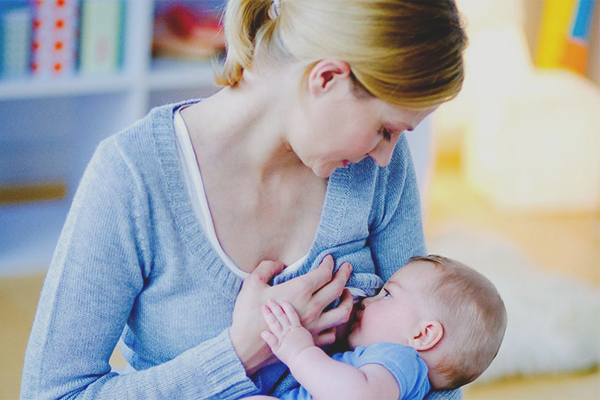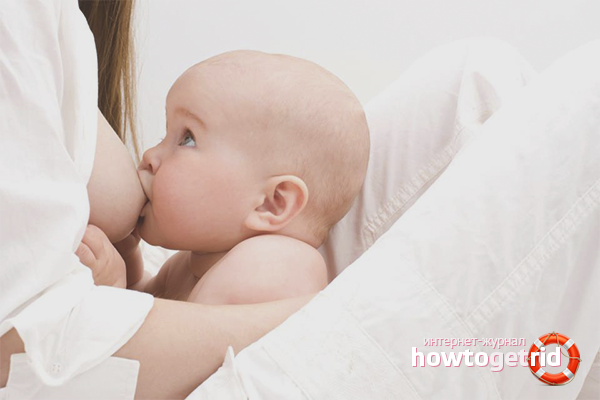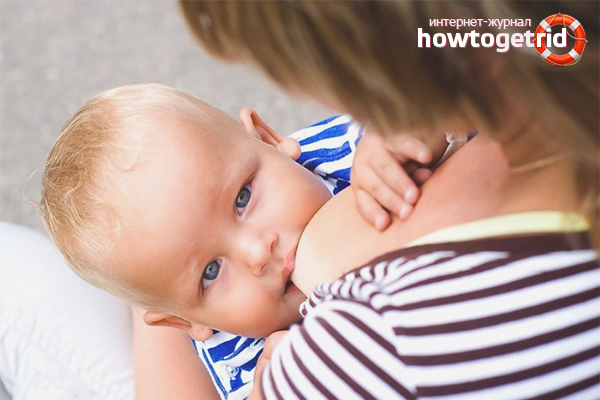The content of the article
Nature has made the female body perfect, able to endure and grow a new life without artificial mixtures and decanting. Breastfeeding is a natural process that does not cause discomfort to the baby and the mother herself. If cracks appear on the nipples, the baby is naughty, refusing to eat, it is time to revise the technique and methods of “feeding” the mammary glands.
Perfect time
You can not listen to the advice of newly minted grandmothers who know "how best", and put the baby to the bust exclusively on schedule. In the first 4–8 days after discharge, the child will literally hang on the breast of the mother. It is necessary that the baby has developed its own feeding schedule, and the female body understood how much milk should be produced per day.
Having survived a week of peculiar slavery, the young mother will have the opportunity to relax and do her own business.An infant will ask for a breast a maximum of 12 times a day, and eat enough for 20 minutes, and then sleep soundly. Well-fed children rarely act up, gain weight faster than others, and get sick less. Mother's milk is a source of a sustainable immune system.
It is necessary to offer food to the baby before bedtime, after waking up and in situations when he is going to cry. You can not give up the night feeding, otherwise lactation deteriorates. And in order not to run to the baby’s crib twenty times in three hours, you can put the baby next to you.
Choose a position
The success of feeding depends on the posture in which both the woman and the baby are. It is important for the baby to feel safe and not to balance in the air between the body of the mother and her hands. It is necessary to take into account several nuances that will facilitate breastfeeding:
- The baby should cuddle up to the woman not with her back or side, but with the stomach.
- Hold the baby tightly so that he does not crawl and fall. You can put next to him on the bed, and pressed to the body with his hands.
- It is impossible to firmly fix the head of a child in a certain position. He himself moves to the maternal bust, and not vice versa.The lower part of the head should be supported so that the neck remains free and the baby does not rest his chin on his chest.
- A woman should not be tense, or feel discomfort. Comfortable posture helps to relax, and facilitates feeding.
Sitting position
You can lean your back on the sofa or headboard by placing the baby on your arm, or bend over it. If he eats the right breast, he should clasp it with his left limb. The brush holds the head, and the body of the child lies on the forearm, and rests against the bent elbow.
Option for women after cesarean section:
- Expand the baby's booty to the chest so that his legs are behind the mother’s back.
- Put it on a special or regular pillow, turning on its side so that its belly is in contact with the nursing body. The lips of the baby are in contact with the mammary gland.
- Maintain palms lower part of the head and neck. Elbow to hold the baby to himself so that he does not crawl from the pillow.
Almost resort
Mom can relax, sitting on her side, and putting the baby next to her. When offering the lower chest, you should support the head of the child, but not constrain the movement of small arms and legs.If it is difficult for the infant to suck milk from the bust, or if it stagnates, it is advised to give him the upper gland. Putting a pillow under her head, the mother leans slightly over the baby and puts her free hand on his back or ass.
Tired mothers can put newborns on a pillow, not forgetting to hold, and offer breasts. If the first signs of lactostasis appear, it is advised to try a pose where the woman with the baby lies with a jack.
Restless eaters
Crumbs who love to wave their hands, or choke with milk, will like the pose on the back. Mom should put a pillow under her or several, taking a half-sitting position. To press the child to itself a tummy, and to move closer to a food source.
If the milk stagnates in the bust, it is recommended to feed the baby, standing on all fours. You can turn to crumbs from different angles, choosing the most convenient. There is nothing funny or ugly in such a position, because it helps a woman avoid mastitis.
We activate reflexes
A breast for a child is like a huge sandwich with ten layers of sausage for an adult.Appetizing, but how to put in your mouth? Nature has prudently laid the necessary reactions in the baby’s head, but they should be launched.
- Place the mammary gland in front of the nose, not the baby’s lips or chin. Otherwise, he will not be able to open his mouth as widely as necessary.
- Touch the nipple or finger to the tip of the nose of the baby and lower lip. This is a kind of signal for the brain that arouses the appetite and makes you look for a source of food.
- If the baby doesn’t understand what to do with her mother’s breast, they advise you to express some milk, and wet the lips of the baby, or drink it with a spoon. Remembering the native taste, he will definitely want to continue the meal.
Responsible moment
When the baby realizes that the time has come to have a good snack, and his mouth opens wide, you need to slightly flatten the mammary gland.
- Fold your fingers to the sides, a few inches higher from the areola.
- Squeeze the nipple to come forward.
The mammary gland should fit compactly into the baby’s open mouth so that it captures as much as possible.
Correctly, if:
- The nipple rests against the baby’s palate, as if inviting “come to me.” This gesture makes the child actively work the lower jaw, drinking all the milk to the last drop.
- Almost the entire areola disappears in the infant's mouth.If the child “terrorizes” only the nipple, cracks appear on the chest, and the baby itself has to work a lot with its jaw to get food. The baby starts to get nervous, and over time refuses breastfeeding.
- Mom does not feel pain. Discomfort is the first signal that the process is going wrong and you need to change something.
- The lower lip of the crumbs protrudes forward, a tongue may lie on it. His cheeks were rounded, and did not fall inward, and it is not visible how the muscles of the jaw work. So milk is going well and the baby doesn’t have to try its best.
- After feeding, the mammary gland is completely emptied, or baby food remains “on the bottom”.
It is necessary to thrust a breast when the child widely opens a mouth, as if yawning. The lips at this moment resemble the wings of a butterfly. If you try to shove the nipple into the half-open mouth, the baby will capture only a part of the bust, and it will be inconvenient for him to eat, he will quickly get tired and remain hungry.
Movement must be fast so that the baby does not have time to close the jaw. If the mother felt pain when the nipple was in the baby’s mouth, you should tickle the baby or press on the chin.Did not help? It is advised to hold the nostrils to block the access of air. When the baby spits out his chest, remove his fingers.
Important: Sometimes children are naughty, pushing away or spitting out the mammary glands. You can not give up. You should calmly continue offering baby nipples until he agrees to have breakfast or lunch.
Typical mistakes
Babies from birth to six months do not need anything other than breast milk. The exception is made by children on artificial feeding. Quite often, newly-minted parents make mistakes under the pressure of “experienced” relatives.
- So that the child prematurely did not refuse natural food, and did not reluctantly get food from his chest, you should not give him a bottle. It is much easier to work the jaw, squeezing milk from a rubber piece, than from mom's bust.
- A crying baby is better to offer a breast than a nipple. She is small, and a child can unlearn how to open her mouth so widely that a nipple with an areola can fit into it. Soothers and bottles form an incorrect bite in the infant, which is why the mother bust suffers and cracks appear.
- Crumbs enough milk.No need to solder it with boiled water, poke juice or vegetable puree. Complementary food is a direct path to indigestion, colic and diseases of the digestive organs.
- Baby is fed with one breast, and not alternated. The first milk is liquid and replaces water. The remains is thicker, resembling colostrum, and in them a high concentration of nutrients. The infant must empty one breast, and the next time the second. So mom protects herself from stagnation and mastitis.
- The child must not only suck, but also breathe. That's right, when his chin is pressed against the bust of a woman, and there is a small gap between his chest and nose. The baby, who lacks oxygen, begins to choke, get nervous, and refuses to continue the banquet.
- You can not sharply pull the nipple from the mouth of the crumbs. A woman injures her own breast, and scares the child. It is necessary to loosen the grip, putting your little finger in the corner of the mouth, and gently pry the mammary gland.
- The baby should not slurp or smack loudly, chew nipples. It means that it is difficult for him to get milk, and it should be taken out, and after that he should put his chest between the jaws of a baby.
Mothers with nipples pulled in will help to adapt to the breastfeeding special linings. Although the child adapts to virtually any shape and type of mammary glands, the main thing is to offer them correctly.
Milk - the first protection of the infant from disease, and the guarantor of its normal development. Moms who have mastered the subtleties and nuances of breastfeeding, receive from the process only pleasure and positive emotions. They rarely experience breast inflammation, mastitis, and nipple cracks.
Video: how to put the baby to the chest














To send